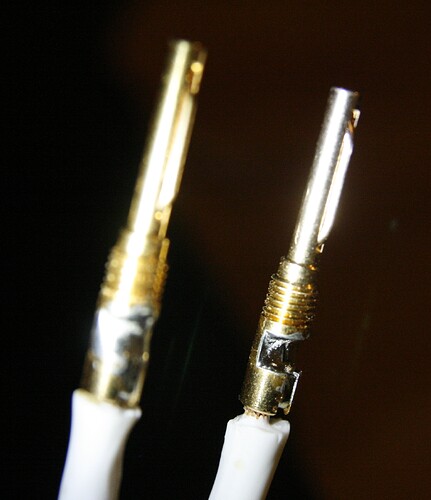I like your opinion  . But how do you know if it is broken or not?
. But how do you know if it is broken or not?
I think what you can do mathematically or physically (by measuring, doing visual inspection) – do it. What you can‘t – do by your ears, eyes, nose, etc…
Left speaker plugs:
Left amp plugs:
I’ll post photos of right cable shortly. Really not sure about amps end termination, looks not good to me…
Edit: Too late…
Svetty, I’ve read what you post before “edit”  .
.
It is all about intuition. If your intuition is saying you something, it can’t be ignored. And I think I was right about it. Just look at the photos above, especially at amp end termination.
It’s not the neatest job granted. It looks as if the cable is too thick for the plugs and the guy doing the soldering has got around this by teasing some strands away and running them onto the outside of the plug then soldering.
Whether the conduction is sub-optimal is harder to determine
Right speaker plugs. There are 2 “missing” strands (!). Not “included” in solder (not visible well in photos).
Right amp plugs:
Not good. Chop the lot and re-do it.
All over cooked like an amateur from MasterChef. New pins, new solderer and probably solder…
Yeah, it seems you are right :).
Actually I’ve ordered the Naca5 cable and soldering work at one very well-known online shop (I don’t want to mention the name here). But the most interesting part is that some soldering photos (in older forum) provided as perfect Naca5 soldering are from their site  . And I’ve also read some recommendations from forum members about that they do soldering work perfect. So it seems that it is not true… And that it will be hard to find reliable person for soldering work
. And I’ve also read some recommendations from forum members about that they do soldering work perfect. So it seems that it is not true… And that it will be hard to find reliable person for soldering work 
By the way, is this recommendation (to do re-solder) only for “amp end” plugs or for “speaker end” plugs also?
Speaker end plugs look pretty good for me, despite some “missing” strands from right speaker cable.
Indeed. In fact when I did Naim zigzag, I picked up radio stations. Went back to coiling.
Hi all, does anyone know of a video of the soldering process NACA5 and Naim plugs? Busy practising here, but would love to see an expert complete the task. Thx
The best connectors out there use a crimping sleeve, and torx screws. Check it out on WBT’s website.
The key to soldering NACA5 or any largish wire connection is to make sure your iron has a sufficiently large chisel tip or round sloped tip, and has enough power. A basic regular electronics iron and tip won’t cut it and may provide a weak / imperfect connection.
The entire connection needs to be molten and then set.
I’m going to re think the whole thing and invest in a bigger iron, thanks for the feedback.
This video is not NACA5, but its for similar sized wire & terminal bucket as we have with speaker wires.
The instructions are exactly as would be used in any electrical trade school.
It’s a good video… however they only briefly mention a key consideration with NACA5, as it is copper it is usually best to tin it before you start work to solder the connection.
Tinning for those that don’t know, is melting a thin layer of solder over the cleaned (with emery cloth or similar) copper exposed and trimmed on the NACA5 cable, brush off any flux, and then follow the steps as shown in the video Mike refers to.
2 schools of thought on that one Simon, with clean copper, the correct heat & fluxed solder, it flows well without it. Yes its helpful in some jobs & its something we taught in trade school to do with large cables & terminals (e.g. automotive starter cables). But not so on smaller wires such as on PCB
IME soldering NACA5 into the pins used in the angled Naim plugs I found its easier not to tin. with the chisel tip pushing the wire tight into the solder groove its always flowed well for me.
Yep on larger copper wires as used in antennas (and NACA5) we were and I believe they still do teach to tin before soldering. I think it’s also about ensuring any oxidisation is removed, and if the tinning is dull it’s easy to identify before the connection is made…
Of course oxidisation in a connection can cause issues… with high end audio and RF alike as well as with strength.
If it’s a tiny copper wire then sure simply clean with emery cloth and fairly promptly make the connection.
But you know what you are doing anyway and what to look out for … it’s the cleaning of the wire that is important and promptly soldering the connection… and knowing how and what to look for to confirm a successful connection is made, I guess tinning provides a lievel of assurance when required.
I was trained to tin absolutely everything first except A5 as it needed to be pressed firm into the Naim pins which was very hard to do on a tinned bit of A5.
















